Python programming
- 1. PYTHON PROGRAMMING BY CH SRILAKSHMI PRASANNA
- 2. INTRODUCTION TO PYTHON • Object-oriented programming language • Guido van Rossum in 1989. • National Research Institute for Mathematics and Computer Science • Netherlands • The comedy group Monty Python.
- 3. FEATURES OF PYTHON • Versatile • High Level programming • Extensible • Easy maintenance • Robust • Multi threaded • Garbage collection • Secure
- 4. APPLICATIONS OF PYTHON • Build a website • Develop a game • Perform Computer Vision (Facilities like face-detection and color-detection) • Implement Machine Learning (Give a computer the ability to learn) • Enable Robotics with Python • Perform Web Scraping (Harvest data from websites) • Perform Data Analysis using Python • Automate a web browser • Perform Scripting in Python • Perform Scientific Computing using Python • Build Artificial Intelligence
- 5. APPLICATIONS OF PYTHON • brands like YouTube, Dropbox, and Netflix • Search-engine Google
- 6. VARIABLES AND IDENTIFIERS • X=20 • Names starts with letters, numbers, underscores.
- 7. DATA TYPES • Variables can hold values of different types called data types. • Assigning or Initializing values of variables:
- 8. MULTIPLE ASSIGNMENT • Allows to assign a single value to More than one variable.
- 9. BOOLEAN • Data type • True Or False • Comparing values
- 11. KEYWORDS and exec not assert finally or break for pass class from print continue global raise def if return del import try elif in while else is with except lambda yield
- 12. INDENTATION • Python provides no braces to indicate blocks of code for class and function definitions or flow control. Blocks of code are denoted by line indentation.
- 14. OPERATORS
- 18. EXAMPLES OF RELATIONAL OPERATOR
- 21. LOGICAL OPERATOR
- 23. MEMBERSHIP OPERATOR • test whether a value is a member of a sequence. • The sequence may be a list, a string, or a tuple. • Two membership python operators • ‘in’ and ‘not in’.
- 24. EXAMPLES FOR MEMBERSHIP OPERATOR
- 25. IDENTITY OPERATORS • Identity operators are used to compare the objects. • not if they are equal, but if they are actually the same object, with the same memory location: • There are different identity operators such as • ‘is’ operator – Returns true if both variables are the same object • ‘is not’ operator - Returns true if both variables are not the same object.
- 28. DECISION CONTROL STATEMENTS • It decides the sequence in which the instructions in a program are to be executed. • Instructions can be one or more. • 3 types of control statements : • Sequential • Selection • Iteration
- 29. SEQUENTIAL STATEMENTS • Sequential statements :are a set of statements whose execution process happens in a sequence. The problem with sequential statements is that if the logic has broken in any one of the lines, then the complete source code execution will break.
- 30. SELECTION/DECISION CONTROL STATEMENTS • Selection statements are also known as Decision control statements or branching statements. • The selection statement allows a program to test several conditions and execute instructions based on which condition is true. • Some Decision Control Statements are: • Simple if • if-else • nested if • if-elif-else
- 31. Simple if
- 32. if-else
- 33. Nested iF
- 34. if-elif-else
- 35. ITERATIVE/ LOOPING STATEMENTS • used to repeat a group(block) of programming instructions. • two loops/iterative statements: • for loop • while loop
- 36. for loop • for loop: A for loop is used to iterate over a sequence that is either a list, tuple, dictionary, or a set. • We can execute a set of statements once for each item in a list, tuple, or dictionary.
- 37. for loop
- 38. Range function() • The range() function returns a sequence of numbers, starting from 0 by default, and increments by 1 (by default), and stops before a specified number.
- 39. while loop • With the while loop we can execute a set of statements as long as a condition is true.
- 40. THE BREAK STATEMENT • With the break statement we can stop the loop even if the while condition is true:
- 41. THE CONTINUE STATEMENT • With the continue statement we can stop the current iteration, and continue with the next:
- 42. DATA STRUCTURES IN PYTHON • Organizing, • managing and • storing data • Data Structures allows you to organize your data in such a way that enables you to store collections of data, relate them and perform operations on them accordingly. Easier access and efficient modifications
- 43. DATA STRUCTURES IN PYTHON • Types of Data Structures in Python
- 44. TYPES OF DATA STRUCTURES IN PYTHON • Python has implicit support for Data Structures which enable you to store and access data. • Built-in Data Structures • These Data Structures are built-in with Python which makes programming easier and helps programmers use them to obtain solutions faster. • Lists • Lists are used to store data of different data types in a sequential manner. • There are addresses assigned to every element of the list, which is called as Index. • The index value starts from 0 and goes on until the last element called the positive index. • Negative indexing which starts from -1 enabling you to access elements from the last to first.
- 45. LISTS • Creating a list:
- 46. LISTS • Adding Elements: • append() • extend() • insert() functions • The append() function- adds all the elements passed to it as a single element. • The extend() function- adds the elements one-by-one into the list. • The insert() function- adds the element passed to the index value and increase the size of the list too.
- 47. LISTS • Adding Elements: • The append() function- adds all the elements passed to it as a single element.
- 48. LISTS • Adding Elements: • The extend() function- adds the elements one-by-one into the list.
- 49. LISTS • Adding Elements: • The insert() function- adds the element passed to the index value and increase the size of the list too.
- 50. LISTS • Deleting Elements: • To delete elements, use the del keyword. • If you want the element back, you use the pop() function which takes the index value. • To remove an element by its value, you use the remove() function.
- 51. LISTS • Accessing Elements: pass the index values and hence can obtain the values as needed.
- 53. LISTS • Other Functions: • The len(): function returns the length of the list. • The index(): function finds the index value of value passed where it has been encountered the first time. • The count() :function finds the count of the value passed to it. • The sorted() and sort(): functions do the same thing, that is to sort the values of the list. The sorted() has a return type whereas the sort() modifies the original list.
- 55. LISTS • Other Functions: • concatenate- method 1
- 56. LISTS • Other Functions: • concatenate- method 2
- 57. LISTS • Other Functions: • concatenate- method 3 ( list comprehension ) list=[expression for variables in sequence]
- 58. LISTS • Other Functions: • concatenate- method 4 ( using *)
- 59. LISTS • Other Functions: • list.remove(x): Remove the first item from the list whose value is equal to x. It raises a ValueError if there is no such item. • list.reverse():Reverse the elements of the list in place. • list.copy():Return a shallow copy of the list. Equivalent to a[:].
- 60. LISTS • Other Functions: list.pop([i]):Remove the item at the given position in the list, and return it. If no index is specified, a.pop() removes and returns the last item in the list. list.clear(): Remove all items from the list. Equivalent to del a[:].
- 61. USING LISTS AS STACKS • The list as a stack, where the last element added is the first element retrieved (“last-in, first-out”). To add an item to the top of the stack, use append(). To retrieve an item from the top of the stack, use pop() without an explicit index.
- 62. USING LISTS AS QUEUES • List as a queue, where the first element added is the first element retrieved (“first-in, first-out”); however, lists are not efficient for this purpose. While appends and pops from the end of list are fast, doing inserts or pops from the beginning of a list is slow (because all of the other elements have to be shifted by one).
























































![LISTS
• Other Functions:
• concatenate- method 3 ( list comprehension ) list=[expression for variables
in sequence]](https://image.slidesharecdn.com/pythonprogramming-220122144854/85/Python-programming-57-320.jpg)

![LISTS
• Other Functions:
• list.remove(x): Remove the first item from the list whose value is equal to x. It
raises a ValueError if there is no such item.
• list.reverse():Reverse the elements of the list in place.
• list.copy():Return a shallow copy of the list. Equivalent to a[:].](https://image.slidesharecdn.com/pythonprogramming-220122144854/85/Python-programming-59-320.jpg)
![LISTS
• Other Functions:
list.pop([i]):Remove the item at the given position in the list, and return it. If no
index is specified, a.pop() removes and returns the last item in the list.
list.clear(): Remove all items from the list. Equivalent to del a[:].](https://image.slidesharecdn.com/pythonprogramming-220122144854/85/Python-programming-60-320.jpg)















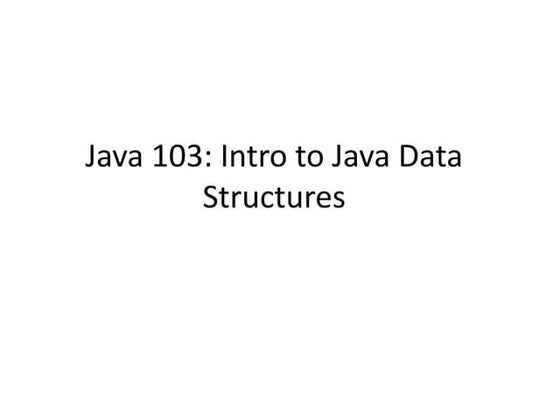

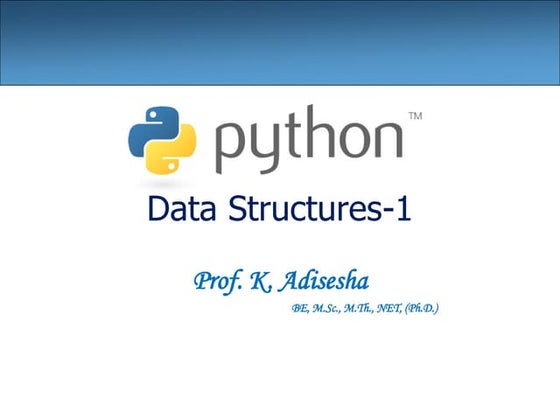




















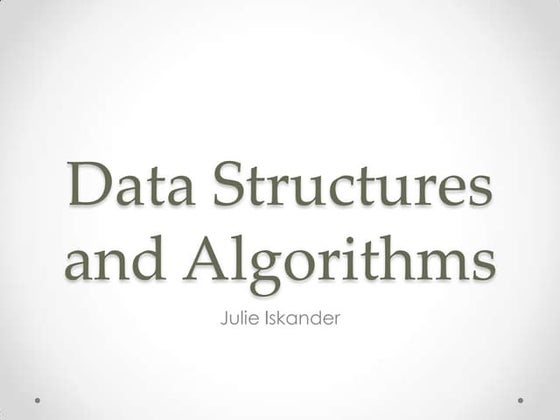

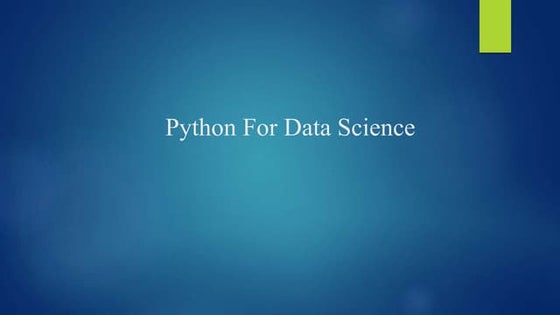




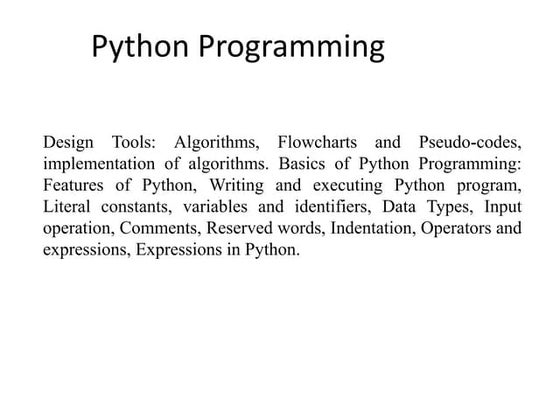
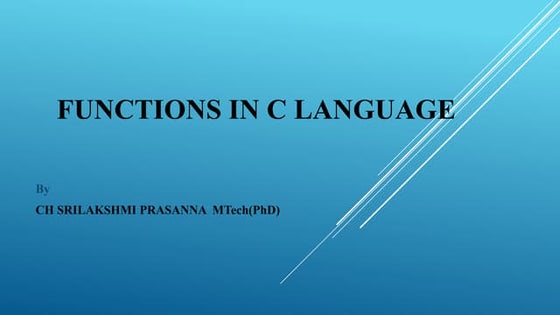



















![MODULE 01 - CLOUD COMPUTING [BIS 613D] .pptx](https://cdn.slidesharecdn.com/ss_thumbnails/module01-cloudcomputing-250409082345-d719f5bc-thumbnail.jpg?width=560&fit=bounds)






